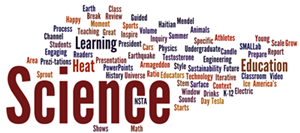
Now from the Boston Museum of Science Sci-tech today on NECN.
有线新闻波士顿消息。
We are headed to the moon on Sci-tech today. NASA recently launched two robotic missions in an effort to learn more about the moon and its environment. Joining us now from the Museum of Science Boston is researcher Tony Case, a graduate student at Boston University. Good to have you with us, Tony. Good to be here, thanks for having me.
今天我们来关注的是关于月球的消息,美国国家航空和宇宙航行局(NASA)近期投放了两枚人造卫星以探知月球及其周围环境。来自波士顿大学的研究生Tony Case将和我们一起解读这则消息。很高兴见到你,Tony。谢谢,很高兴来到这儿。
So what can you tell us about these missions?
那么,对于这项月球任务你知道多少呢?
Well, LRO is a spacecraft that's around the moon right now. It's orbiting really close to the surface. It's about 30 miles above the surface of the moon. And there're seven instruments on the spacecraft, they are all taking a wide array of measurements of the entire surface of the moon. Along with LRO launching on the same rocket was another spacecraft called LCROSS, which is on its way to the moon now. And the main goal of both of these missions was basically that open an advance scout to gather information that might enable us go back to the moon more safely and more easily in the future if we choose to do so with manned missions.
目前,月球勘测轨道器(Lunar Reconnaissance Orbiter,简称LRO)正在沿着月球表面运行。这颗人造卫星距离月球表面只有30英里,它所承载的7种相关仪器正在对月球进行一系列的探测。与LRO一同发射的还有月球坑观测和传感卫星(Lunar Crater Observation And Sensing Satellite,简称LCROSS) ,现在正在逐渐靠近月球。这两项月球计划旨在收集更多的信息,为将来月球的载人探测任务提供更安全舒适的保障。
Interesting, alright in the long names of these, the Lunar Reconnaissance Orbiter is the LRO and the Lunar Crater Observation and Sensing Satellite is LCROSS.That's right.
有趣的是,LRO代表着月球勘探器,LCROSS表示月球坑观测和传感卫星。是的。
What kind of information do we need to get from these satellites to help us to someday return to the moon.
从这两颗人造卫星的名称就能看出我们为将来成功登月正在收集什么样的信息。
Well LRO is giving us a lot of different information and the one piece of information that is personally close to my heart is the instrument that I worked on and what it measures is radiation—the radiation environment around the moon. So this radiation is, it's energetic particles that are coming from outside of the solar system and also from our own sun. And it can cause damage both to human cells and to electronics. So this is the instrument we built to measure that radiation. It's called CRATER — the Cosmic Ray Telescope for the Effects of Radiation. So this is around the moon now this is a testing version but the flight model is around the moon. And it's measuring the radiation right now.
LRO发回了许多信息,其中一条我最关心的,也是我正在研究的就是测量辐射的仪器。辐射是来自外太阳系和太阳本身的能量分子,它能伤害人类的细胞,同时对通信行业也有影响。这是我们发明的辐射测量仪,叫做CRATER(Cosmic Ray Telescope for the Effects of Radiation),但这只是测试版,正式版正在人造卫星上测量辐射强度。
All right, and that was developed at BU and MIT.
是波士顿大学和麻省理工学院两所大学研发的。
It was, yeah, along with other institutions ,but yeah it was headed here in Boston.
恩,是的,联合了其它大学共同研发,但是是由波士顿大学带头的。
Pretty exciting. What about water? They are looking for water and how important it is to find it or not find it?
很有趣。那么水呢?科学家们正在月球上寻找水源,能不能找到水源有多重要呢?
Well yeah.That's one of the main goals of both the LRO mission and the LCROSS mission to find water along with any other resources that we might be able to use. So LRO is..ha..has different imagers that are taking images of the surface that might tell us whether there is water there, and also the LCROSS spacecraft is designed almost exclusively to search for this water. So LCROSS has it launched along with LRO on the same rocket and when we detached from LCROSS, it stayed attached to the empty fuel tank left over from the rocket. So tomorrow morning about 7:30 in the morning LCROSS releases the fuel tank. The fuel tank flies in to the surface of the moon, impacts and throws up a huge dust cloud. So hopefully in this dust cloud, will be dust along with anything else that might have been mixed in along with the regulus on the moon in the soil. And so as LCROSS flies to this dust could, it's able to measure everything that's in that dust hopefully confirming the presence of water.
是的,LRO和LCROSS的发射最主要的目的就是寻找水源,这两颗人造卫星传回的数据结合其他数据我们也许就能加以判断。LRO的成像器会拍摄月球表面的照片,LCROSS几乎就是专门用来探测水源的。在LCROSS和LRO从发射火箭中分离后,LCROSS仍旧和空的燃料罐绑定。明天早上7:30,LCROSS将会释放燃料罐,燃料罐撞击月球形成大量尘埃云,月球表面的锑和其他物质就会被扬起,在LCROSS靠近的过程中就会分析尘埃云中的物质,希望我们可以证明水的存在。
ll right very very interesting, TONY CASE, a graduate student of BU. Thanks very much for joining us. Thanks a lot.
真的是非常有趣,TONY CASE,波士顿大学的一名研究生。感谢你的介绍。谢谢。
And we will let people know that tomorrow at the Museum of Science from 9 to 1 you can watch a video of LCROSS impact and see presentations by the CRATER team they will be on hand to answer questions about LRO and LCROSS and to demonstrate the instrument.
我们要告诉观众们的是,明天9点到下午1点科技博物馆将放映LCROSS撞击的录像,CRATER研究组会到现场展示探测仪器并解答您的问题。
taking a wide array of measurements: 做各类测试
regulus :锑块;金属渣
注:本篇文章英文来自普特论坛,译文属可可英语原创,未经允许,请勿转载。











